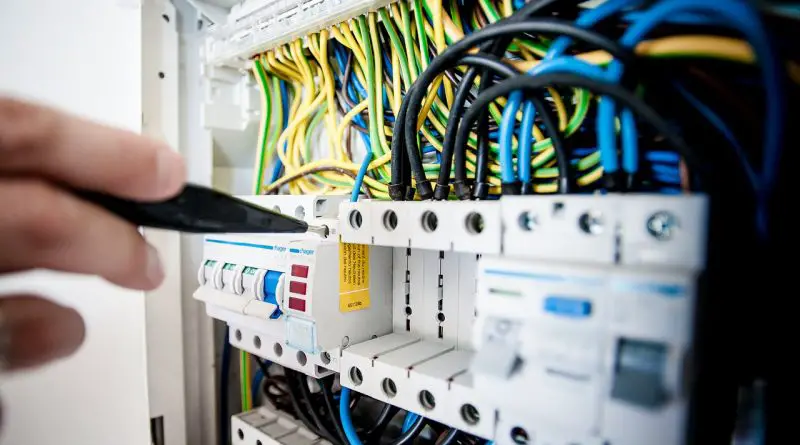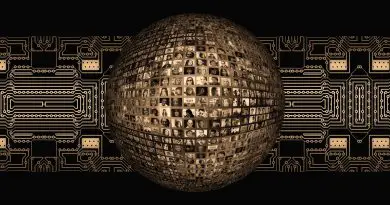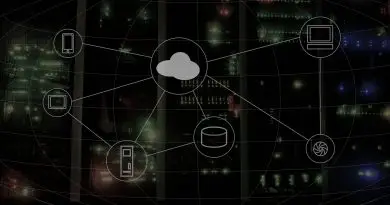What is Ethernet In Data Transmission ?
We have already learned about the topologies used in computer networks. Both Internet and ATM (asynchronous transfer mode) are designed for wide area networking. But in many applications, a large number of computers are to be connected to each other. For such a scenario LAN (local area network) is introduced. The most common LAN is the Ethernet.
Further, the LAN has seen several technologies such as Ethernet, Token Ring, Token Bus, FDDI, and ATM LAN. But Ethernet is by far the dominant technology. The IEEE 802.3 standard is commonly called as the Ethernet. It is a bus-based broadcast network with decentralized control.
The IEEE basically subdivided the data link layer into two sublayers i.e. logical link control (LLC) and the media access control (MAC). IEEE further created several physical layer standards for different LAN protocols.

IEEE 802 format has created a sublayer called media access control (already discussed in the previous posts) that defines the specific access method for each LAN. For example, it also defines CSMA/CD as the media access method (already seen in the previous post) for ethernet LANs and the token passing method for Token Ring and Token Bus LANs.
Computers on an Ethernet can transmit any time they want to do so. If two or more machines transmit simultaneously, then their packets collide. Then the transmitting computers (hosts) just wait for an arbitrary time and again retransmit their signal.
Why it is called ‘Ethernet’ ?
This system is called as Ethernet after the luminiferous ether through which the electromagnetic radiation was once thought to propagate.
The transmission medium is thick coaxial cable (called ether) upto 2.5 km long. Repeaters are placed after every 500 meters. Up to 256 machines can be attached to the multidrop cable.
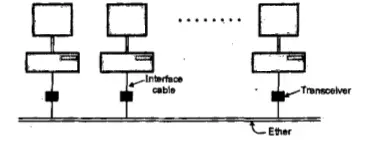
Computer connected to Internet via LAN (Ethernet cable)
When a computer is connected to the Internet via LAN, it has to use all the five layers of the internet model. The three upper layers (network, transport, and application) are common to all the LANs.
The data link layer is divided into two sublayers namely the logical link control (LLC) and the medium access control sublayer (MAC). The MAC sublayer and physical layer of various LANs will be different from each other.
Ethernet doesn’t provide any mechanism for acknowledging received frames, making it what we call an unreliable medium.
Ethernet Frame Format
Now let us understand the frame format in ethernet :

Preamble: The first field of the 802.3 frame contains 7 bytes (56 bits) of alternating Os and Is that alerts the receiving system to the coming frame and enables it to synchronize its input timing.
Start frame delimiter (SFD): The second field (l byte: 10101011) will signal the beginning of a frame. The SFD warns the station or stations that , it is the last chance for synchronization.
Destination address (DA): The DA field is 6 bytes and contains the physical address of the destination station or stations to receive the packet.
Source address (SA): The SA field is of 6 bytes and contains the physical address of the sender of the packet.
Length or type: This field can be defined as a type of field or length field. The original Ethernet used this field as the type field in order to define the upper-layer protocol using the MAC frame.
Data: This field mainly carries data encapsulated from the upper-layer protocols.
CRC: The last field generally contains error detection information.
Why Ethernet has been so successful?
First, an ethernet is extremely easy to administer and maintain. There are no switches, which can fall, no routing, or tables that have to be kept up-to-date. We can add new host easily to this network second, it is inexpensive, the cable is cheap.
The 10 Mbps standard Ethernet has undergone several changes before moving to higher data rates. Let us now see the changes (evolution) of the ethernet :
What is Bridged Ethernet ?
There are two effects of using bridges on Ethernet LANs. They are as follows:
- They increase the bandwidth
- They separate the collision domains
The bridge can help increase the bandwidth per station. A bridge basically divides the network into two or more networks. Each such network is independent of the others and each one will have the full 10 Mbps bandwidth.
A Bridge is a layer 2 networking device, using bridge any similar LANs can be interconnected. It is working under DLL (data link layer) and thus can able to read the MAC addresses.
Each new network now has 5 stations and each network is independent bandwidth wise can have a capacity of 10 Mbps. Thus the use of bridges increases the bandwidth per station.
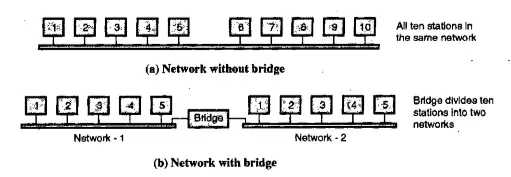
With the use of bridge, the collision domain becomes much smaller and the probability of collision is reduced because a smaller number of stations now compete for the access of the medium.
Without bridging all the 12 stations compete for access to the medium and with bridging only 3 stations would compete for access to the medium.
Bridge Algorithm (Frame forwarding procedure)
Step 1 : When a frame is received, verify the DA (destination address) and received a port (input port) .
Step 2 : Select the output port from the forwarding table on DA.
Step 3 : If the input and output port not the same, then forward the received frame through output port, after regeneration.
Step 4 : If the input and output port the same then , discard the frame.
Step 5 : If DA is broadcasting address, broadcast the received frame after regeneration.
Full Duplex Ethernet
Due to the full-duplex mode. the capacity of each domain increases from 10 to 20 Mbps. We have to use two communication links between each station and the switch. One of the links is used to send data and the other one is used to receive it.
The full-duplex switched Ethernet does not need CSMA/CD because there is no more need for carrier sensing.
Stay tuned for the next important topic related to the data link layer in the OSI model.

Aric is a tech enthusiast , who love to write about the tech related products and ‘How To’ blogs . IT Engineer by profession , right now working in the Automation field in a Software product company . The other hobbies includes singing , trekking and writing blogs .

